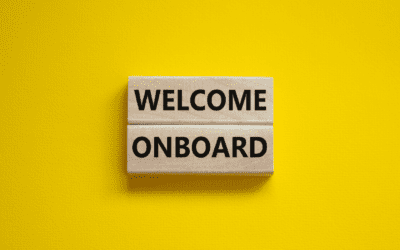The first day at a new job can be nerve-wracking, with new faces and processes to learn, and a solid onboarding welcome letter sets the stage for an employee’s journey in your company.
Our guide will show you how to craft a letter that eases worries and makes newcomers feel part of the team fast.
Keep reading – it’s simpler than you think!
Key Takeaways
- Start your welcome letter with a friendly greeting and a personal touch. Use the new employee’s name to make them feel valued.
- Include key company information like core values, culture, and expectations in the letter to introduce the new hire to their workplace environment.
- Share essential first-day details such as start time, dress code, where to go, and who they’ll be working with so they can prepare for their first day.
- Send the welcome letter after the job offer is accepted to show you’re excited about having them on board.
- Personalize each letter by mentioning specific talents or interests of the new employee, which shows you pay attention and care about their individuality.
Understanding the Importance of a New Hire Welcome Letter
Transitioning seamlessly from our introductory remarks, let’s delve into why a new hire welcome letter is not just a piece of paper but an influential touchpoint in the onboarding process.
Crafting this document with care goes beyond mere formality; it sets the stage for employee success and fosters immediate engagement with your company culture. This personalized gesture acknowledges that every individual stepping through your doors contributes to the corporate tapestry, bringing unique threads essential for vibrant brand awareness.
An effective welcome letter acts as an icebreaker between new employees and what can often feel like the daunting expanse of a new work environment. It reflects your organization’s commitment to transparency, immediately opening communication lines.
Think of it as providing a roadmap—outlining company values, mission, and policies—and highlighting available perks ranging from dress code specifics to LinkedIn introductions for team integration.
Moreover, by preemptively addressing frequently asked questions about various aspects such as privacy or goal setting within their roles, you equip newcomers with knowledge that helps mitigate first-day jitters and underscores integrity at its core—an investment in cultivating autonomous professionals who feel valued from day one.
Key Elements of an Effective Onboarding Welcome Letter
Crafting an onboarding welcome letter that resonates with new employees is an art form—striking the perfect balance of warmth, information, and personalization lays the groundwork for a lasting impression.
Uncover the finesse behind penning a missive that introduces and truly integrates a newcomer into your corporate family.
A Warm Introduction
Start your welcome letter with a friendly greeting. Use the new employee’s name to make it feel personal. Say something like, “Hello [Name], we’re thrilled to have you join our team!” This sets a positive tone right from the start.
Explain that everyone is excited and looking forward to working with them.
Next, introduce yourself briefly. Mention your role in the company and how you’ll be involved in their onboarding process. Keep it light but informative so they know who to contact for help.
You might write, “I’m [Your Name], the front desk manager and I’ll be helping you settle in during your first week.” This adds a human touch and starts building a connection between you and the new hire from day one.
Presenting the Company’s Core Values and Culture
Your welcome letter is a powerful tool to share what we stand for here at our company. It’s your chance to highlight our mission, vision, and the core values that drive us daily.
Picture this as a map guiding new team members through our cultural landscape. Think of it like planting seeds in fertile soil—those principles will grow with them as they become part of our work family.
Let newcomers know they’re stepping into a place where their unique skills add value to an ongoing story. Here, everyone contributes to creating something unique—a workplace fueled by respect, innovation, and cooperation.
Dive into illustrating examples of how these values play out in daily operations. Maybe it’s weekly team huddles or volunteer days; whatever brings our culture to life should shine through in your words!
Providing Essential Information for the New Hire
Give new hires everything they need to start strong. Packets and emails full of vital details come in handy. Include company policies, your mission, orientation schedules, and contact lists.
Lay out the groundwork for their role with clear job descriptions and expectations.
Make sure they know where to turn if questions pop up. Slip in a QR code or links to resources like the employee handbook or HR’s inbox. Share info on team introductions and how the first week will look.
This step sets them up for success from day one!
Personalization for a Welcoming Touch
Use the new employee’s name in your welcome letter. It shows you know who they are and cares about their start with your team. Share a story or detail that connects them to the company right away.
Maybe mention how their skills remind you of someone successful at the firm or relate their interests to an upcoming company event.
Add something unique for each person you’re writing to. It could be a comment on their impressive resume, excitement about what they bring from Springfield, or the perfect timing with spring around the corner.
These small things can make new hires feel seen and essential before day one begins.
Step-by-Step Guide to Drafting a Welcome Letter
Crafting the perfect welcome letter can seem daunting, but fear not – I’ve got you covered with a foolproof blueprint. This step-by-step guide will help you create an engaging and informative welcome that will resonate with your new team members from day one.
Setting Your Objectives
Before writing your welcome letter, decide what you want to achieve. Think about the key messages you’re trying to send. You aim to make your new employee feel valued and excited, right? You also need them to understand your company’s culture and what makes it unique—like if you work at a nuclear power plant or a social media start-up.
These goals will shape everything from the tone of your letter to the information you include.
Lay out clear objectives for employee engagement through this letter. Will it introduce team members or outline first-week activities? Maybe it’ll connect them with human resources for any urgent questions they have before day one.
No matter the details, ensure every part of your welcome email serves a purpose in kick-starting their journey with confidence and clarity.
Outlining the Letter
Start with a clear plan for your welcome letter. Ensure it has everything the new employee needs to feel ready and excited. Use headings like “Introduction,” “Company Culture,” and “First Day Details.” This helps you organize your thoughts and cover all key points.
Think about what the new hires should know before they start. Include an overview of the company mission, values, and culture to connect them with the corporate identity from day one.
Provide essential starting information such as work hours, dress code, or anything necessary for a smooth first day. Keep it friendly but professional, ensuring every word shows how much you value their arrival.
Writing the Introduction
Once you’ve outlined your welcome letter, you’re ready to dive into the introduction. A warm, engaging opening can set a friendly tone for everything that follows. Ensure your first sentences have punch – they should make new hires feel excited and valued.
Begin with enthusiasm and a clear message of welcome. Mention how thrilled the team is to have them on board. This isn’t just another email; it’s the beginning of their journey with your company, so highlight their importance to the team and acknowledge the skills they bring to the table immediately.
Keep it light yet professional, reflecting a welcoming corporate culture where everyone is recognized for their contributions from day one.
Introducing Yourself
Now that you have set the stage with a friendly introduction, it’s time to put a face and name to your words. Your welcome letter should include an introduction from someone at the company – perhaps yourself if you are the manager or a team lead.
This makes the experience personal for your new hire. Share who you are, your role in the company, and how excited you are about having them on board.
It’s not just about telling them your job title; let them see your human side, too. Maybe mention something interesting about your work history or what drives you professionally. Keep it short and sweet, but show that there’s a natural person behind this letter ready to support their journey at the company.
This is where employee onboarding begins — building relationships right from day one!
Sharing Crucial Information
Make sure your welcome letter has all the must-know details. New employees need to know what to expect on their first day, including start time, dress code, and where to go.
Give them a heads-up about any paperwork they need to bring or complete. Remember to list key contacts like HR managers or team leads.
Explain how their role helps the company soar and fits the big picture. This motivates new hires right from the start! Slip in info about login credentials if needed, and remind them of resources available for help.
Your goal is clear: make sure that they’re ready to hit the ground running when day one arrives.
Personalizing the Letter
After you’ve shared the essential details, it’s time to give your welcome letter a personal touch. Use the new employee’s name and mention specific talents they bring to the team. This shows you value them as individuals, not just as another resume in the stack.
Include bits about their role and how it fits into the bigger picture of company goals. You might also add a sentence about what excites you most about having them on board.
Add warmth by referencing something from their interview or discussion that stood out. Maybe they are interested in a project your team is working on, or they mentioned a hobby that resonates with someone at the company.
Personalizing makes them feel seen and connected immediately, laying down solid foundations for motivation and branding them as part of the family from day one.
Examples of Welcome Letters
Diving straight into the heart of crafting that perfect welcome letter, let’s talk examples. Imagine a new employee stepping into the unknown territory of your company’s culture and values; what better way to bridge this gap than with a well-composed welcome letter? It speaks volumes without saying much, painting a picture of warmth, structure, and support.
An example might begin with an enthusiastic greeting followed by introductions to crucial team members they’ll work closely with – putting names to faces even before day one.
Every industry has nuances, but whether you’re in tech or textiles, the premise remains consistent: make them feel at home from the get-go. Effective samples often include snippets about company history mingled with fun facts employees won’t find on resumes or job descriptions – think groundbreaking projects or heartwarming team-building retreats.
They set a professional tone while reflecting a sense of belonging; this intricate balance transforms mere words on paper into pathways for meaningful connections right off the bat.
Addressing Frequently Asked Questions
6. Addressing Frequently Asked Questions: Dive deep into the nitty-gritty – from timing to tonality, we tackle those pressing queries that pop up when crafting a newcomer’s first impression, ensuring every base is covered for your peace of mind.
Keep reading; your FAQs are about to become clear as day!
When to Send the Welcome Letter
Send your welcome letter when the new employee accepts the job offer. This shows them you’re excited and ready for their arrival. It’s best to send it a few days before they start.
This gives them time to read about the company’s culture and values. They can also learn what they need for their first day.
Make sure this letter comes from the hiring manager. It should feel personal and set a positive tone for their journey with your team. Include essential information that will help them prepare, like work hours, dress code, or who to ask when they arrive.
Keep it friendly and informative so they know you’re looking forward to having them on board!
Who Should the Welcome Letter Come From
The new employee welcome letter often comes from the hiring manager or team leader. This adds a personal touch to the onboarding process. It shows the new staff member that their immediate supervisor is involved and excited about their arrival.
Higher-ups like the CEO might sometimes step in to send a welcome message, too. It could also come from someone in HR. Either way, getting this email from different company levels makes a new employee feel important and included immediately.
Importance of a Welcome Letter
After deciding who pens the welcome letter, it’s crucial to understand its role in an employee’s journey. A well-crafted welcome letter is a powerful tool. It sets the tone for newcomers’ experience and sparks their enthusiasm about joining the team.
Think of it like a warm handshake on paper—or, in today’s world, perhaps a digital one. This first communication lays down what lies ahead and helps new hires feel valued from day one.
A welcome letter does more than say “hello.” It shows that you recognize the importance of this big career move for them. By sharing core values and company culture, you begin weaving them into the fabric of your organization before they’ve even started.
Plus, including essential onboarding information means less confusion later on. Personal touches make all the difference; they turn standard letters into something memorable—a signpost that guides recruits along their new path with confidence and clarity.
Best Practices for Sending a Welcome Letter
Knowing the value of a welcome letter, sending it at just the right time is vital. Shoot for a time soon after the new hire accepts the job offer. This quick action shows them they are already part of the team.
Ensure your letter comes from someone important – like their future manager or a team leader. It feels more personal and sets up a connection from day one.
Your welcome letter should buzz with excitement and warmth, reflecting how thrilled you are to have them on board. Keep it short; stick to what matters most. Cover essentials such as working hours, dress code, parking details, and where they can find help if needed.
Remember not to overload with information – just enough to prepare them without feeling overwhelmed hits the spot!
Conclusion
Your welcome letter can be a new employee’s first step into your company’s world. Make it count! Show them you care and are ready to support their journey. Remember – warmth, clarity, personality; these make the difference between a good start and a great one.
Now roll out that red carpet with your words, and set up your new team member for success!
FAQs
1. What should you include in a welcome letter to new employees?
Start with a warm greeting! In your onboarding welcome letter, share essential info like start dates and what they can expect on their first day. Talk about the company culture and how happy you are to have them join the team.
2. How does a great welcome letter make new hires feel at home?
A well-crafted letter breaks the ice – it immediately makes newcomers feel valued. It’s your chance to show them there’s support and everyone’s excited about their contributions.
3. Can an onboarding letter help with employee retention?
When folks receive clear, friendly guidance from day one, they’re likelier to stick around. They see this place where people matter; growth is part of the deal.
4. Is adding some fun facts or insider tips in my welcome letter okay?
Absolutely! Sprinkle in some cool tidbits about life at work or pointers only insiders know – it’ll give them something to look forward to and spark conversations with new colleagues.



0 Comments